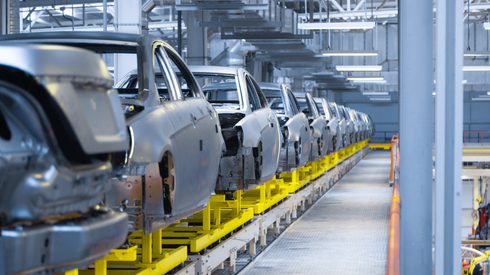The exchange perspective
From an exchange standpoint, ferrous futures volumes have grown for four years in a row and compounded annual growth of more than 45%, said Ian Canton, manager of metals products at the CME Group.
That growth in liquidity has a “snowball effect” that encourages more counterparties to come into the market to hedge ferrous products, he said.
The upshot: “It means better prices, better opportunity to get your hedge off efficiently and less expensively,” Canton said.
And steel’s potential isn’t even close to being realized, he suggested.
“Steel is second to only crude [oil] as a physical underlying market – so that’s where we could get to. And we’re really at the early stages but showing really encouraging signs,” Canton said.
Canton made his comments during a panel discussion titled “Leveraging risk management tools and decisions science to drive value in operations, finance, sales and corporate strategy.”
Alberto Xodo, vice president of sales for the London Metal Exchange, was equally bullish.
“The industry has been hit hard and surprised by changes in the last few years, and I think that has increased the appetite for risk management,” Xodo said.
Another reason that steel derivatives have been more readily adopted recently: Products offered by exchanges such as the LME are better suited to the steel industry now than those offered 10-15 years ago, he said.
Xodo did not specify which product he might have been referring to. But the LME launched a physically settled steel billet contract in 2008. That contract failed to gain traction in the market and was suspended in 2017. The LME has since switched its focus to cash-settled instruments.
The financier and risk-management take
Lewis J. Hart, managing director at Brown Brothers Harriman, a financier of physical commodities, agreed with Canton’s assessment of the potential for ferrous futures.
“It’s been nice to see the adoption rates going up in the industry. But if we look at some of the other commodity sectors that we support, we think steel still has a lot of leg room in terms of increasing even more,” Hart said.
What has been driving the adoption of steel futures is not only volatile prices but also uncertainty about policies – such as Section 232 – that have a direct impact on steel prices, said Spencer Johnson, a risk-management consultant at StoneX Group Inc.
“You’ve seen more price uncertainty introduced throughout the supply chain in steel, both in terms of uncertainty about the future of production and uncertainty about the future of trade and tariffs,” he said.
Case in point: US mills are poised to add millions of tons of new flat-rolled, electric-arc furnace (EAF) capacity over the next three years at a capital cost of billions of dollars. The capacity addition will start next month, when Big River Steel will begin production from a second EAF at its mill campus in Arkansas, and continue over the next three years.
And some market participants are concerned that the additional supply, if it is not met by increased demand or a reduction in older capacity, could push prices lower. Such concerns about a potentially sharp correction have been exacerbated by US hot-rolled coil prices soaring to their highest point in more than 18 months not long after falling to their lowest point in more than four years.
And that is hardly a complete list, Johnson said, noting that price volatility has also been driven by uncertainty about the economy in general, stimulus spending and the outcome of the US presidential election.
Election Day in the United States is Tuesday November 3.
The willingness to use steel derivatives to manage such risks is “night and day” compared with when Johnson started in the industry a decade ago, he said.
Evidence of just how strong the appetite for ferrous derivatives is also comes from exchange volumes increasing even during periods when demand for physical steel has fallen – such as in the immediate aftermath of the Covid-19 outbreak, said Ganesh Natarajan, managing director and head of European operations for Enuit LLC, an energy and commodity risk management company.
“There is a lot more volume even though the demand has dropped, which means people are trying to hedge using CME or any other market venue to manage their risk,” Natarajan said.
Want cash? Hedge it
Another big change is that hedging is increasingly being seen not as a function relevant only to a company’s treasury department or procurement department but as a core function of the entire organization, said Drew Lichter, vice president of strategy and corporate development for Mobius Risk Group.
“In energy, for example, in order to get financing, you have to hedge it,” he said. “The hedging is not just an individual, siloed component.”
Sign up here for Fastmarkets’ free webinar on November 4, 2020, beginning at 9am GMT: European flat steel market – on the mend after the Covid-19 fallout?
– Overview of EU flat steel price developments in 2020 so far
– Suppliers’ response to the drop in demand
– Fortress Europe? Toughening of trade defense measures
– The survival of European steelmakers facing high raw material costs
– Demand contraction and a slow path to recovery
– Near-term price outlook






